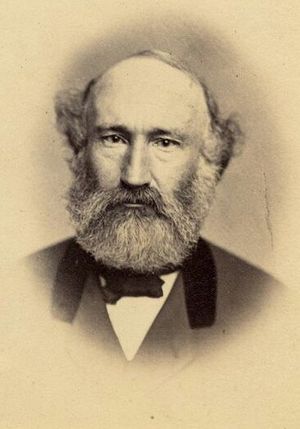William Huntington Russell facts for kids
Quick facts for kids
William Huntington Russell
|
|
|---|---|
 |
|
| Member of the Connecticut House of Representatives for New Haven | |
| In office 1846–1847 |
|
| Personal details | |
| Born | 12 August 1809 Middletown, Connecticut, US |
| Died | 19 May 1885 (aged 75) New Haven, Connecticut, US |
| Resting place | Grove Street Cemetery 41°18′44.532″N 72°55′33.6″W / 41.31237000°N 72.926000°W |
| Political party | Whig, Republican |
| Spouse | Mary Elizabeth Hubbard |
| Relatives | Samuel Russell (cousin) |
| Education | A.L.S. & M. Academy |
| Alma mater | Yale College Yale School of Medicine |
| Occupation | Businessman, educator, politician |
| Known for | Co-founder of Yale secret society Skull & Bones |
William Huntington Russell (born August 12, 1809 – died May 19, 1885) was an important American figure. He was a successful businessman, a dedicated teacher, and a politician. He is especially known for helping to start a famous secret society at Yale University called Skull and Bones.
Contents
Early Life and Education
William Huntington Russell was born in Middletown, Connecticut, on August 12, 1809. He was one of thirteen children. His father, Matthew Talcott Russell, was a Justice of the Peace and a state attorney.
William came from a long line of old New England families. One of his ancestors, Rev. Noadiah Russell, was a founder of Yale College. Even though his older cousin, Samuel Russell, started a big trading company, William was never part of it.
Military Training and College Years
From 1826 to 1828, William attended the American Literary, Scientific and Military Academy. Here, he learned under strict military rules. After his father passed away in 1828, William faced money problems. Despite this, he went to Yale University and graduated in 1833.
Career and Contributions
William Russell first planned to become a minister. However, his financial situation meant he needed to earn money right away. So, he became a teacher.
A Dedicated Educator
From 1833 to 1835, he taught in Princeton, New Jersey. Then, he worked as a tutor at Yale. In 1836, he opened his own private school for boys. This school became famous as the New Haven Collegiate and Commercial Institute.
At first, only a few boys attended. But by the time William Russell died, about 4,000 boys had graduated from his school. While running the Institute, he also went back to Yale and earned a medical degree in 1828.
Around 1840, Russell added strong military training to his school. He believed a Civil War was coming and wanted his students to be ready to fight for the Union. His students were so well-trained that some became drill instructors when the Civil War began.
Service During the Civil War
William Russell also helped the Union army himself. The Governor of Connecticut, William Alfred Buckingham, knew Russell was very knowledgeable about military matters. Because of this, Russell was asked to help organize Connecticut's militia. In 1862, he was made a major-general by the state legislature.
He also served on a special committee in 1863. This committee was appointed by the Secretary of War to inspect and report on West Point, a famous military academy.
Political Life
From 1846 to 1847, Russell served in the Connecticut state legislature. He represented New Haven as a member of the Whig Party.
When the Missouri Compromise was ended in 1854, he became a leader in forming the Republican Party. Later, from 1868 to 1873, Russell worked as the Collector of Internal Revenue for New Haven and Middlesex Counties.
He was a strong supporter of ending slavery, known as an abolitionist. He was also a friend of John Brown, a famous abolitionist. John Brown even named Russell as a trustee in his will. Russell also represented Connecticut on the National Kansas Committee.
Later Life and Legacy
In 1856, William Russell and other members of Skull and Bones officially created the Russell Trust. This organization later became the Russell Trust Association. This association owns the Skull and Bones Hall at Yale University and the society's private island, Deer Island.
Personal Life
On August 19, 1836, William Russell married Mary Elizabeth Hubbard. She was the daughter of Dr. Thomas Hubbard, a professor at the Yale Medical School. William and Mary had ten children together. Six of their children were still alive when William passed away.
Some of their children included:
- Talcott Huntington Russell (1847–1917), who became a lawyer.
- Thomas Hubbard Russell (1851–1916), who became a doctor.
William Huntington Russell passed away in May 1885. He saw some boys throwing stones at birds in a park in New Haven, Connecticut. He tried to protect the birds, but the effort was too much for him. He collapsed and died several days later from a ruptured blood vessel.
Images for kids
See also
 In Spanish: William Huntington Russell para niños
In Spanish: William Huntington Russell para niños


